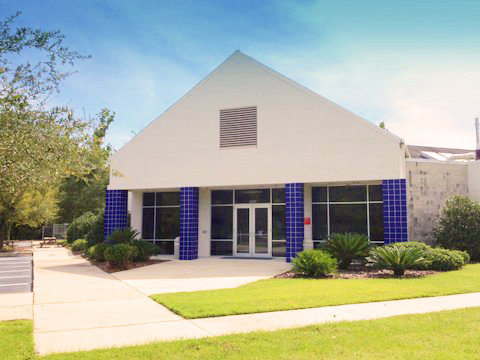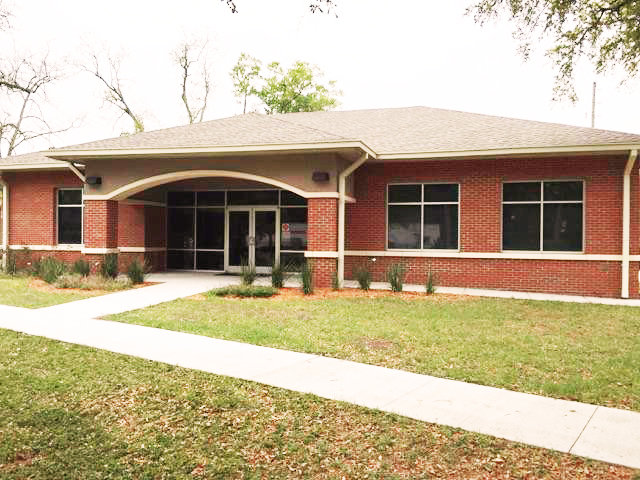HealthStreet : An Innovative Community Engagement Initiative
TM
Funding Through:
UF Clinical and Translational Science Institute
University of Florida – Mt. Sinai Medical Center, 1Florida Alzheimer’s Disease Research Center
Florida Department of Health – Ed and Ethel Moore Alzheimer’s Disease Research Program
Rides and Resources for Rural Residents (R4), Florida Blue Foundation
Catherine W. Striley, PhD, MSW, ACSW, MPE
Hui Hu, PhD
Linda B. Cottler, PhD, MPH




A community engagement program that improves the health of our community by bridging gaps in health care and health research
MISSION
To reduce disparities in healthcare and research
4 AIMS








5,200+ people linked to studies!

Community Health Workers (CHW)
Assess health concerns, conditions and research perceptions of community members
Provide referrals to community members for medical and social services
Provide opportunities to participate in health research, relevant to their health concerns and health conditions

2,055
Enrolled

Navigated
5,201

Contacted
12,721

Informed Consent
10,619

Intake Form Completed
10,233
October 23, 2011 through April 22, 2018
45

Mean Age

African Americans
59%

Food Insecure
47%

Access to Doctors
69%
Making Research Matter
Introduction/Aim
- Racial and ethnic minorities are not likely to be enrolled in research
- Despite demonstrated willingness to participate - Where does the disconnect between community member desire for research participation and actual research participation come from?
Results
- Substantial discordance between community member health conditions/concerns and topics of available studies for them to participate in (see figure in next slide)
Discussion
- The health conditions and health concerns of the community provide a wide range of public health relevant topics
- Faculty research interests may not be aligned with community needs

Corbie-Smith G, Moody-Ayers S & Thrasher AD. Closing the circle between minority inclusion in research and health disparities. Arch. Intern. Med. 164, 1362–1364 (2004).
Fisher, J. A. & Kalbaugh, C. A. Challenging Assumptions About Minority Participation in US Clinical Research. Am. J. Public Health 101, 2217–2222 (2011).
Cottler, L. B. et al. Community Needs, Concerns, and Perceptions About Health Research: Findings From the Clinical and Translational Science Award Sentinel Network. Am. J. Public Health 103, 1685–1692 (2013).
Crooke H, Kwiatkowski E, Nelson DR, Cottler LB, Striley CW. Making Research Matter: Consequential Public Health as a Framework for Disparities in Enrollment into Health Research. Journal of Epidemiology and Community Health, under review.
Comparison of Health Concerns and Conditions from Community-recruited participants, and Available, Openly Recruiting Health Research Studies
(sorted in descending order of health concern prevalence)*
*Health Concern percentages calculated out of the number of HealthStreet members who provided at least one health concern as of March 2016 (n=6,724);
Health Condition percentages calculated out of the total HealthStreet member population with completed Health Intake Forms as of March 2016 (n=7,354);
Research Study topic percentages calculated out of all openly recruiting health research studies available to HealthStreet members as of March 2016 (n=90)

TM
TM
TM


- Our project complements new statewide AD efforts with UF, Mount Sinai Medical Center, Memory Disorder Clinics, and other institutions to give Floridians an unprecedented opportunity to be part of cutting-edge AD screening, treatment and research.
- We will develop a Florida AD Registry for early screening of underrepresented older adults in the community. The registry, protected with a Data Trust, would facilitate linkage between community members and the research enterprise to detect mild cognitive impairment (MCI) through diagnostic and therapeutic initiatives.

- The project will launch an innovative, statewide community focused outreach program for underrepresented, diverse populations from three regions with the highest AD mortality.
- Through Community Health Workers, 3,600 older adults will be assessed for MCI, social determinants, medical history, perceptions of and trust in AD research, and family history of AD.
- We will link 360 65+ year olds with MCI in the new Florida AD Registry to research across Florida and eventually to a national patient powered network for AD.
- With ongoing person-centered contact, and an expert team, we will track our efforts to increase AD knowledge, trust in research, recruitment, enrollment and retention in AD research that improves health.
Saturation Map of HealthStreet
TM
Neighborhood Deprivation Index (NDI)
NDI was generated based on block group-level SES Indicators from the 2010-2014 American Community Survey:
- Poverty: % HHs in poverty, % HHs earning <$30,000/year, % HHs with no vehicle
- Occupation: % males(females) in management or professional occupations
- Housing: % rented housing, % vacant housing, % renter/owner costs>50% income, median home values
- Employment: % unemployed, % males no longer in work force
- Education: % <high school education
- Racial composition: % non-Hispanic blacks
- Residential stability: % in same residence in the last year, % residents ≥65 years old
74% HealthStreet participants are from areas with high deprivation*
Messer, Lynne C., Barbara A. Laraia, Jay S. Kaufman, Janet Eyster, Claudia Holzman, Jennifer Culhane, Irma Elo, Jessica G. Burke, and Patricia O’campo. "The development of a standardized neighborhood deprivation index." Journal of Urban Health 83, no. 6 (2006): 1041-1062.
* Neighborhoods with NDI higher than the state median (-0.25)
TM
Effectiveness of the Community Navigation Model
Hot Spots
Cancer (7.8%)
Hypertension (35.0%)
Diabetes (13.2%)
Hot Spots
Obesity (38.3%)
Depression (26.8%)
Past Month Use of Prescription Opioids (13.7%)
HealthStreet Frequent ED Utilizers
- Characterized as ≥ 2 visits in the past 6-months
- Super-utilization is generally associated with:
- Age- young adults and seniors
- Females
- Racial/ethnic minorities
- Lower rates of employment
- Higher rates of poverty
- Less education
- Medicare or Medicaid coverage - Between 4.6 to 8.0% of ED users are super-utilizers
- These individuals account for between 21 to 28% of all visits - After controlling for age and gender, men with 3 – 5 chronic diseases had 6.33 AOR and women with 3 – 5 chronic diseases 3.49 AOR as those with no chronic diseases. Significant AORs remained after adjusting for age, gender, depression, marital status, employment status and food insecurity (4.98 AOR and 2.49 AOR respectively)
LaCalle E, Rabin E. Frequent users of emergency departments: the myths, the data, and the policy implications. Annals of emergency medicine. Jul 2010;56(1):42-48.
Vinton DT, Capp R, Rooks SP, Abbott JT, Ginde AA. Frequent users of US emergency departments: characteristics and opportunities for intervention. Emergency medicine journal : EMJ. Jan 28 2014.
Milani S, Crooke H, Cottler LB, Striley CW. Sex differences in frequent ED use among those with multimorbid chronic disease. American Journal of Emergency Medicine. In Press. Oct 2016; http://dx.doi.org/10.1016/j.ajem.2016.07.059
TM
